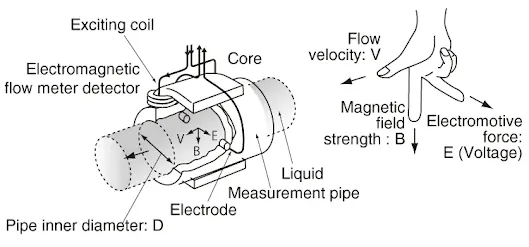PRINCIPLES
Electromagnetic flow meters detect flow by using Faraday's Law of induction.
According to this principle, when a conductive medium passes through a magnetic field B, a voltage E is generated which is proportional to the velocity v of the medium, the density of the magnetic field and the length of the conductor.
Inside an electromagnetic flow meter, there is an electromagnetic coil that generates a magnetic field, and electrodes that capture electromotive force(voltage). Due to this, although it may appear as if there is nothing inside the flow pipe of an electromagnetic flow meter, flow can be measured.
There is one important point when using electromagnetic flow meters. Because electromagnetic flow meters are based on the laws of electromagnetic induction, conductive liquids are the only liquids for which flow can be detected. This electromagnetic flow meter being non intrusive type, can be used in general for any fluid which is having a reasonable electrical conductivity above 10 microsiemens/cm.
Under Faraday's law of induction, moving conductive liquids inside of a magnetic field generates an electromotive force (voltage) in which the pipe inner diameter, magnetic field strength, and average flow velocity are all proportional. In other words, the flow velocity of liquid moving in a magnetic field is converted into electricity. (E is proportional to V × B × D)

